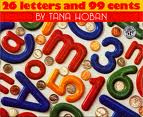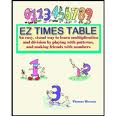Many of you have come across Tana Hoban’s fun books. Her 26 Letters and 99 Cents will delight your preschool to kindergarden child or even an older child who has trouble figuring out how to add pennies, nickels, dimes and quarters. This book is in fact two books in one. One book presents upper and lower-case letters beside colorful objects beginning with that letter.
Turn the book OVER and numbers are pictured with pennies, nickels, dimes and quarters totaling that amount. Your child is learning not only about numbers and grouping but also money. While reading this book to your child, expand the lessons by having a pocketful of change on the table and having your child figure out how many ways to make 35 cents with all pennies, or all nickels or a combination of coins. Your child is learning number concepts and addition. Why not develop your child’s “number sense” at an early age? This fun book will engage your child!
What are your child’s favorite Tana Hoban books?

